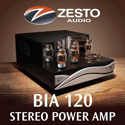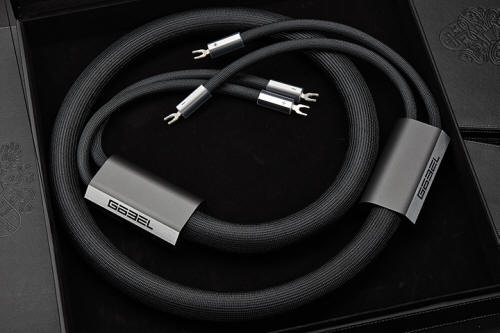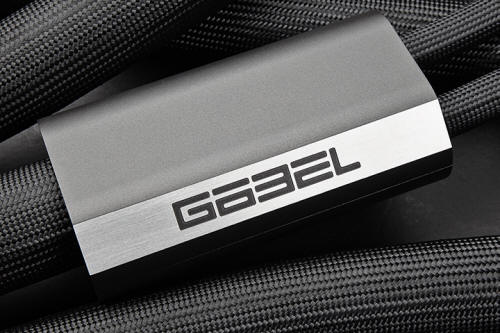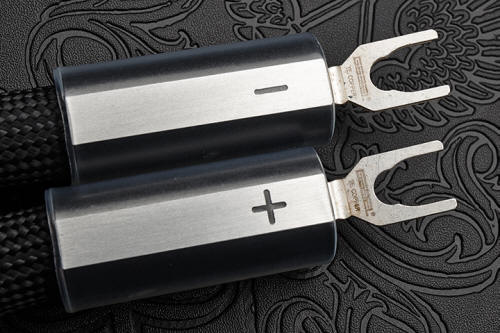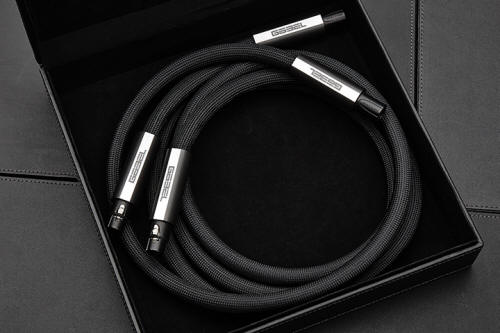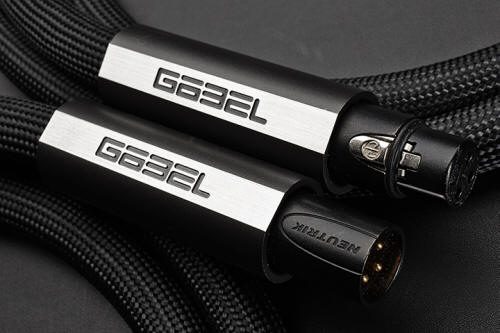|
|
You are reading the older HTML site
Positive Feedback ISSUE 75
göbel Lacorde Statement XLR and Loudspeaker Cables as reviewed by Dirk Sommer
Oliver Göbel quite harmlessly called me and asked if I would be interested in listening to his new cables. Since I am continuously impressed by his speakers, I spontaneously said yes to his question. He came over, we listened, I was enthusiastic and we arranged a review. We had not spoken about prices then. An embossed coat of arms and decorative stitching on the packaging, lots of aluminum with engraved company name: Oliver Göbel knows how to stage his products. But first: The sound is even better than the outward appearance. Since I knew for what sum his sonically fascinating, milled from solid aluminum sculptures—Vulgo speakers—changed hands, I had not exactly expected low-cost cables. In addition, more than 20 years of high-end review writing has left its mark: No price shocks me too quickly. It didn't bother me one bit that I was sharing my listening room for quite a period of time with a Continuum turntable and matching tonearm carrying a six-figure sum in the price list. It was only bad when the Continuum was picked up and taken away again. In addition, you can only be conditionally outraged when using a LumenWhite as a work machine (so-called oligarch hifi) if you want to remain reasonably credible. On the other hand, I am extremely satisfied, listening to my files through a D/A converter, which does not even cost as much as five meters of the best USB cable from Audioquest. The fear of products from the upper or lower end of the price scale are largely foreign to me. So we repress all thoughts of the filthy lucre, and take a closer look at the cables.
The Lacorde Reference Speaker cable is much lighter than it looks at first glance. It sounds anything but lightweight. When Oliver Göbel brought over the balanced signal and speaker cables from the Lacorde Statement line to the test review, he didn't give much away regarding questions about the construction of the conductor. At least I was able to get out of him that for both applications, a vast number of the same, individually insulated conductors with the same diameter were employed. Of course, for the speaker cables, significantly more strands of wire were used to reach a larger cross section. The alloy for the fine, drawn wires consist of copper, silver, and a third material, that Oliver Göbel does not want to name. Experiments had shown that a cryogenic treatment provided no sonic improvements to the alloy. The most difficult stage of development was to determine the most harmonious relationship between the measurements of resistance, inductance and capacity and to realize it through the cable's geometry. The individual wires were specially woven to achieve the desired parameters. Almost as complicated was to ensure by the construction of the cable, that the geometry of woven wires would still last, even after years of use. Pressed Teflon was used as the dielectric. He used natural rubber and neoprene for damping and stabilization of the structure. The outer weaving is specially woven for Göbel High End. He also made sure that the cable is not being statically charged. That's why he did not employ any PVC. The cable is completely made in Germany—he only purchases the "raw wire" abroad. In order to "build" the cable in the standard lengths of three meters for the speaker cable and 1.2 meters for the XLR cable, 15 respectively five hours of work by hand was required, because the finished product was never just cut into pieces and terminated from the roll. The XLR connectors are heavily modified Neutrik models, the spades for the speaker cables are in-house developments, which were pressed on to the end of the cables with a force of 60 tons.
The splitbox really only has the task of covering the junction of the actual wiring to the connectors. But due to their weight they also stabilize the relatively light cable thereby preventing any microphonic effects. The Lacorde Statement is packaged in a fine box, which is adorned with an embossed Goebel family coat of arms. The speaker cables are much lighter than one would expect when seeing them. The majority of the weight is from the exquisitely made so-called split boxes, hiding the junction of the actual wiring to the connectors for plus and minus. It is also evident from the feel and presentation that the Lacorde Statements have the right to play in the highest league. The only small shortcoming: The XLR cable just doesn't want to get along with the Mytek converter. It's not at all about the sound, but only the mechanics: The connectors in the small DAC are just too close together for the hefty Lacorde Statement XLR's. No one would really be tempted to connect a pro-audio grade converter to high-end cables costing many times more than the component. Cable tests are for many colleagues and myself not really popular because the findings are not easily transferable. The result strongly depends on the electrical parameters of the connected inputs and outputs. For that reason, I'm glad I tried connecting the Lacorde Statement speaker cables between the Ayon tube power amp and the LumenWhite speakers as well as from the Ayon to the Acapella Violon and the transistor Viola Concerto and the Lumen. And the result was still just as good—probably the understatement of the year! In the first brief encounter with the Göbel cable, the Acapella Violon stood in the listening room. Beside the power cable, the entire system was connected all with Swiss Cables that had inspired the previous test with superb transparency, distinctive detail and expansive spatial impressions. However, in conjunction with the Lumen it was missing a little warmth. With the Acapella, however, I didn't miss anything at all in this part of the frequency spectrum.
The spades, manufactured for Göbel High End, are made of silver-plated tellurium copper. The change over to the Lacorde Statement brought about more details and created a larger room with more realistic instruments. The low frequency range seemed to be minimally stronger, but thanks to the colorfulness and perfect definition, it was not too much of a good thing. The differences were so clear to comprehend that it needed no further changing of connections. Simply unbelievable that so much resolution can be accompanied by such strong tonality and such a rich foundation! With this speaker cable you do not need to exchange advantages in certain disciplines for disadvantages in others. You definitely know this phenomenon as well: A cable or a component, which has slightly leaner bass or a slight accentuation in the upper midrange, subjectively has better transparency. On the other hand, a thoroughly enjoyable, slightly fatter upper bass reproduction takes away from openness. Not so with the Lacorde Statement: Here there is more fine detail and air, yet not the slightest hint of coolness or fatigue.
Very elegant, but impractical for test purposes: The Lacorde Statement XLRs do not have any markings to identify the right or left channel. Since changing the Lacorde Statement XLR between pre and power amp, and later between pre amp and phono stage the same stunning results were true—in all disciplines a little more of the good and in none, less. It was clear to me that I will have to describe the Göbel cable to you in more detail. In the meantime, I asked about the price: The speaker cable costs €10,000 Euros in the standard length, the XLR cable €2,500. Although that is quite "cracking," it is still overshadowed by the Audioquest Wild. I tried a little self-appeasement—until Oliver Göbel just casually remarked that his prices are, of course, per cable, not per stereo pair. But even that could not change my opinion after my first listening impressions while testing the noble cables. When the Lacordes are found in my listening room the second time, the Lumen has resumed its rightful place again. It is quickly clear that an earthy, colorful and slightly comfortably warm bass does not have to be accompanied by a loss of information: With the Lacorde Statement, you do not have to choose between a huge imaginary space or melodic, refined, yet rich bass response. Here, you absolutely get both! The advantages of Lacorde Statement XLRs are also confirmed in various configurations: Between tube pre and power amp, between the Violas with their semiconductors, between Einstein's The Turntable's Choice using van den Hul's The Grail SB and the Viola Crescendo, but also, on the input side, the EAR 912 equipped with step-up transformers. I'm sorry, I can not see any basis for criticism with the Göbel Lacorde Statement—well maybe just one: The design of the XLR connectors unfortunately precludes use with equipment that have terminals placed very close together. Before you start raving with unfounded fanaticism about cables priced beyond good and evil, very briefly: The Lacorde Statement are the best cables I have ever heard with my system. STATEMENT Oliver Göbel proves with his creations that we neither need to give up a solid bass foundation in order to get outstanding spatial illusion, nor the highest resolution in order to enjoy a colorful low frequency range with lots of power. The Göbel High End Lacorde Statement conjures a little more out of your system in every discipline. Unfortunately, this comes at a price. Anyone who doesn't need to worry about that must be quite happy.
The XLR connector inserts are from Neutrik, most of the rest is made by Göbel. Goebel High End Lacorde Statement XLR
Goebel High End Lacorde Statement Speaker Cable
Goebel High End |






